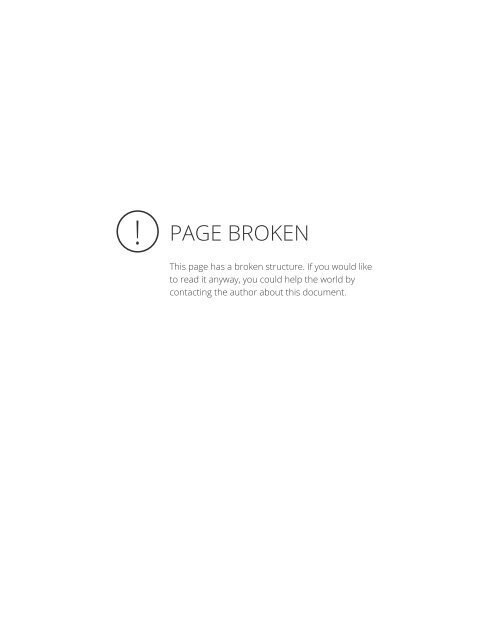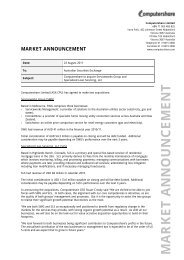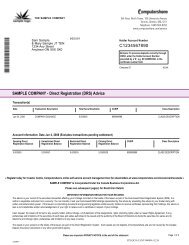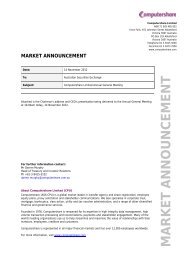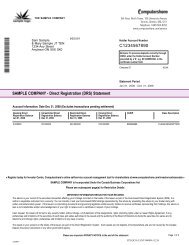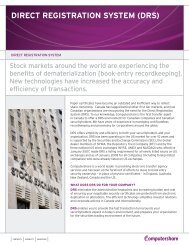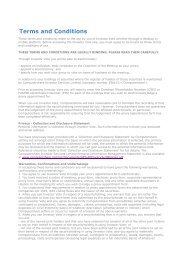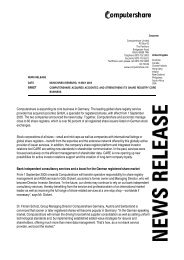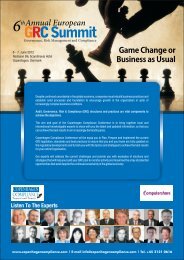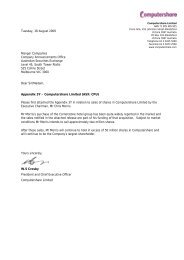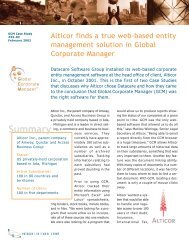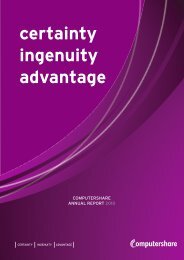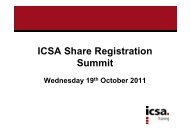COMPUTERSHARE ANNUAL REPORT 2008
COMPUTERSHARE ANNUAL REPORT 2008
COMPUTERSHARE ANNUAL REPORT 2008
You also want an ePaper? Increase the reach of your titles
YUMPU automatically turns print PDFs into web optimized ePapers that Google loves.
HedgingThe Group documents at the inception of the transaction the relationship between hedging instruments and hedged items, aswell as its risk management objective and strategy for undertaking various hedge transactions. The Group also documents itsassessment, both at hedge inception and on an ongoing basis, of whether the derivatives that are used in hedging transactions havebeen and will continue to be highly effective in offsetting changes in fair values or cash flows of hedged items.i. Hedge of net investmentChanges in the fair value of foreign currency debt balances that are designated and qualify as hedging instruments are recordedin equity in the foreign currency translation reserve. The change in value of the net investment is recorded in the foreign currencytranslation reserve in accordance with AASB 121 requirements. The gain or loss relating to the ineffective portion is recognisedimmediately in the income statement.ii. Cash flow hedgeThe Group uses interest rate derivatives to manage interest rate exposure. These derivatives are entered into as part of a hedgingrelationship.The effective portion of changes in the fair value of derivatives that are designated and qualify as cash flow hedges is recognised inequity in the cash flow hedge reserve. The gain or loss relating to the ineffective portion is recognised immediately in the incomestatement.Amounts accumulated in equity are recycled in the income statement in the periods when the hedged item will affect profit or loss(for instance when the future cash flows that are hedged take place).When a hedging instrument expires or is sold or terminated, or when a hedge no longer meets the criteria for hedge accounting,any cumulative gain or loss existing in equity at that time remains in equity and is recognised when the forecast transaction isultimately recognised in the income statement.iii. Fair value hedgeThe Group uses interest rate derivatives to manage the fixed interest exposure that arises as a result of notes issued as part of theUS Senior Notes. Changes in the fair value of these derivatives are recorded in the income statement, together with any changes inthe fair value of the hedged liabilities that are attributable to the hedged risk.iv. Derivatives that do not qualify for hedge accountingCertain forward exchange contracts and foreign currency options do not qualify for hedge accounting. Changes in the fair value ofany derivative instrument that does not qualify for hedge accounting are recognised immediately in the income statement.Fair value estimationThe fair value of financial assets and financial liabilities must be estimated for recognition and measurement or fordisclosure purposes.The fair market value of financial instruments traded in active markets (such as available for sale securities) is on quoted marketprices at the balance sheet date. The quoted market price used for financial assets held by the Group is the current bid price.The fair value of financial instruments that are not traded in an active market is determined using valuation techniques. The Groupuses a variety of methods and makes assumptions that are based on market conditions existing at each balance date. Valuationtechniques, such as estimated discounted cash flows, are used to determine the fair value of the remaining financial instruments.02-13Overview14-36Governance37-88Financials89-92ReportsNew accounting standards and interpretationsCertain new accounting standards and interpretations have been published that are not mandatory for 30 June <strong>2008</strong> reportingperiods. The Group’s assessment of the impact of these new standards and interpretations is below.AASB 8 Operating Segments and AASB 2007-3 Amendments to Australian Accounting Standards arising from AASB 8AASB 8 and AASB 2007-3 are effective for annual reporting periods commencing on or after 1 January 2009. AASB 8 will result ina significant change in the approach to segment reporting, as it requires adoption of a “management approach” to reporting on thefinancial performance. The information being reported will be based on what the key decision-makers use internally for evaluatingsegment performance and deciding how to allocate resources to operating segments. The Group has not yet decided when to adoptAASB 8. Application of AASB 8 may result in different segments, segment results and different type of information being reported inthe segment note of the financial report. However, it will not affect any of the amounts recognised in the financial statements.93-96Further InformationPAGE 47


